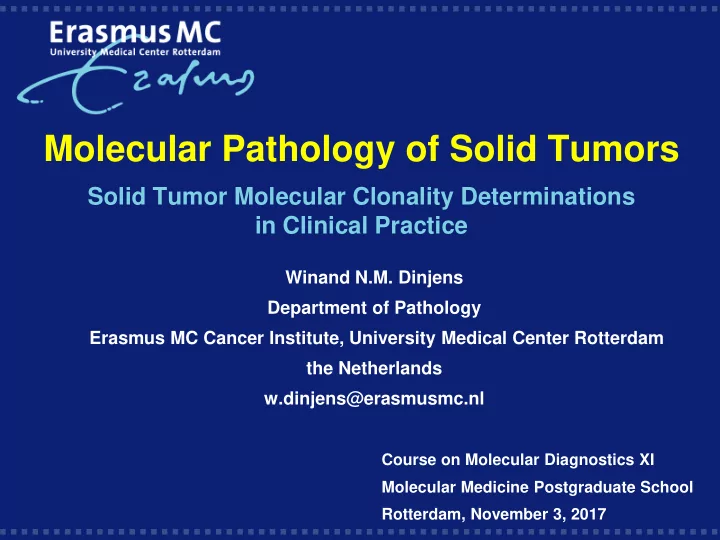

Molecular Pathology of Solid Tumors Solid Tumor Molecular Clonality Determinations in Clinical Practice Winand N.M. Dinjens Department of Pathology Erasmus MC Cancer Institute, University Medical Center Rotterdam the Netherlands w.dinjens@erasmusmc.nl Course on Molecular Diagnostics XI Molecular Medicine Postgraduate School Rotterdam, November 3, 2017
Disclosures Translational research fees: AstraZeneca Financial support: Thermo Fisher, Life Member advisory board GI cancer: Amgen BV Consultancy: Roche
Diagnostic problem: * Patient with two or more synchronous or metachronous tumors * Independent primaries or primary and metastasis? HNSCC / lung adenocarcinoma; HNSCC / lung SCC * Treatment with curative intent versus palliative treatment (important for individual patient)
Cancer is a disease of the DNA Tumor cells differ from normal cells by the presence of DNA aberrations
Genomic aberrations in tumor cells versus normal cells: (Genomic aberrations as result of genomic instability) * Specific genomic aberrations causally related to the transformation of normal cell to tumor cell or to progression of transformed cell: - Drivers Non-specific genomic aberrations: * - Passengers/Hitchhikers - Fragile genomic sites/regions - Age related genomic aberrations
Tumor cells differ from normal cells by the presence of DNA aberrations * (part of the) Genomic aberrations can be regarded as tumor specific clonal markers Genomic aberrations can be used to determine the * relationship between multiple tumors within one patient (multiple primaries or metastatic disease)
Diagnostic Case: woman 78 years: Endometrioid endometrium carcinoma of the uterus (T1) Adenocarcinoma in the right ovarium (T2) Question: two independent primary tumors or metastatic disease? NGS approach: Ion Torrent PGM.
DNA isolation from tumor and normal tissue: * Routine formalin fixed and paraffin embedded tissues * Manual microdissection of tumor and normal tissue from FFPE sections cytology preps, stained or unstained routine H&E stained sections routine IHC stained sections
DNA isolation from routine Pathology (FFPE) specimens Paraffin block Immuno stained section Paraffin section (stained) cytology preparation H&E stained section
High % tumor cells for DNA isolation: manual or laser capture microdissection
DNA isolation: Tissue fragments in Tris/HCl, pH 8.0 + Prot K + Chelex 100 resin (w or w/o deparaffinisation) O.N. 56 0 C 10 min 95 0 C and centrifugation Supernatant used for short-amplicon PCR
THE ION TORRENT NGS • Allows simultaneous detection of mutations in multiple genes in routine pathology specimens • in very small lesions, biopsies and cytology material – requires low DNA input (<10 ng) • in crude preparations of inferior quality FFPE-derived DNA • sensitive detection of mutations in background of wt DNA • custum made gene panels are easily generated
NEXT GENERATION SEQUENCING ION TORRENT S5XL
Cancer hotspot panel V2: 207 primer pairs, amplicon size 111-187 base pairs
Normal cell DNA Tumor cell DNA DNA isolation DNA amplification (PCR) Tumor cells : normal cells = 1 : 1 Mutant DNA 2x (25%) Wild type DNA 6x (75%) Single molecule cloning and sequencing
One molecule per agarose bead
one agarose bead per micell Emulsion PCR (cloning)
Emulsion PCR (cloning)
Chip sequencing one agarose bead per well Per well determination of DNA sequence 60 wells wild type signal 20 wells mutation
mutatie A mutatie B wildtype B wildtype A
Chip sequencing (each well one bead): Fragment A: wildtype Fragment B: wildtype Fragment A: mutation Fragment B: mutation
Amplicon 1 Amplicon 2 Amplicon 3 Amplicon 4 Sample 1 Sample 2 Sample 3 Sample 4
Sample 1 Sample 2 Sample 3 Sample 4 Amplicon 1 Amplicon 2 Amplicon 3 Amplicon 4
S5XL chip Chips: 520: 5 miljoen reads output 530: 20 miljoen reads output 540: 80 miljoen reads output
NEXT GENERATION SEQUENCING ION TORRENT S5XL
PGM chip
Proton release is detected
Analyse NGS resultaten – Integrative Genomics Viewer (IGV) KRAS p.G12C; c.34G>T coverage A = nucleotide variant Referentie sequentie
T1 Endometrium: 80%T H&E before dissection after dissection H&E P53 IHC
T2 Ovarium: 80%T H&E before dissection after dissection na iso P53 IHC H&E
T1: Endometrium KRAS p.G13D Ref_Cov Var_Cov Coverage 1691 792 2483 Ref_Freq Var_Freq 68.10% 31.90% T2: Ovarium KRAS p.G13D Ref_Cov Var_Cov Coverage 1174 1031 2205 Ref_Freq Var_Freq 53.24% 46.76%
T1: Endometrium PTEN p.R130G Ref_Cov Var_Cov Coverage 1035 2186 3222 Ref_Freq Var_Freq 32.15% 67.85% T2: Ovarium PTEN p.R130G Ref_Cov Var_Cov Coverage 206 1827 2034 Ref_Freq Var_Freq 10.18% 89.82%
T1: Uterus CDH1 p.V365I Ref_Cov Var_Cov Coverage 1680 781 2461 Ref_Freq Var_Freq 68.26% 31.74% T2: Ovarium CDH1 p.V365I Ref_Cov Var_Cov Coverage 985 723 1708 Ref_Freq Var_Freq 57.67% 42.33%
Results Identical molecular aberrations in endometrium and ovarium tumor (homogeneity): KRAS c.G38A:p.G13D PTEN: c.C388G:p.R103G CDH1: c.G1093A:p.V365I FBXW7: c.G1436T:p.R479L
Results Both tumors have multiple identical molecular aberrations Conclusion: Endometrioid endometrium tumor and ovarium tumor most likely one entity: primary and metasasis
Conclusions: Detection of molecular aberrations in tumors is possible in routine specimens Results supply significant information on the relationship between multiple tumors within one patient Results have impact on clinical treatment
KMBP KMBP Senior i.o. Techs Ronald Ina Esther Peggy Erik Jan van Marion Geurts-Giele Korpershoek Atmodimedjo Dubbink Techs Techs ISH NGS Hein Ludo Isabelle Hanna Dorine Carolina Laura Sleddens Uytdewilligen Schoep Meijssen den Toom Valente Moonen Techs NGS Bio- Secr. Pathol. Inf. Marit Albertina Lotte Shelly Niels Margot Jan Dirkx-van der de Haan Bierhuizen Douglas-Berger van den Akker Krol von der Thüsen Velden
Thank you for your attention
Recommend
More recommend